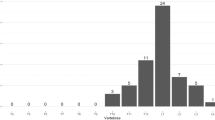Abstract
Spine fracture prevalence is similar in men and women, increasing from <5% in those <60 to 11% in those 70–79 and 18% in those ≥80 years. Prevalence was higher with age, lower bone mineral density (BMD), and in those meeting criteria for spine imaging. Most subjects with spine fractures were unaware of them.
Similar content being viewed by others
Avoid common mistakes on your manuscript.
The electronic supplementary material presented here complements the article “Spine fracture prevalence in a nationally representative sample of US women and men aged ≥40 years: results from the National Health and Nutrition Examination Survey (NHANES) 2013-2014” [1].
Key scientific question
The key scientific questions addressed in this paper are (1) what is the prevalence of spine fractures in US adults ≥40 years of age based on DXA-based vertebral fracture assessment (VFA) and (2) what are the risk factors?
Key findings
Overall vertebral fracture prevalence was 5.4%; prevalence increased with age in both genders (in individuals aged 70 plus, prevalence was 10–20%) and was higher in those with lower bone mineral density BMD, lower BMI, and in those meeting NOF criteria for proactive screening vertebral imaging.
Importance, timeliness, and interest
Since we found that only 8% of individuals diagnosed with a vertebral fracture actually had a self-reported history of vertebral fracture, it is imperative that vertebral imaging be done to identify patients with these fractures as part of a comprehensive risk assessment.
Significance of findings
Individuals with prevalent vertebral fractures are at very high risk of further fractures in both the spine and the rest of the skeleton and require osteoporosis treatment. Finding these fractures by VFA could help reduce the burden of subsequent fractures.
Reference
Cosman F, Krege JH, Looker C, Schousboe JT, Fan B, Sarafrazi Isfahani N, Shepherd JA, Krohn KD, Steiger P, Wilson KE, Genant HK (2017) Spine fracture prevalence in a nationally representative sample of US women and men aged ≥40 years: results from the National Health and Nutrition Examination Survey (NHANES) 2013–2014. Osteoporos Int. doi:10.1007/s00198-017-3948-9
Author information
Authors and Affiliations
Corresponding author
Electronic supplementary material
ESM 1
(PPTX 29446 kb)
Rights and permissions
About this article
Cite this article
Cosman, F. Spine fracture prevalence in a nationally representative sample of US women and men aged ≥40 years: results from the National Health and Nutrition Examination Survey (NHANES) 2013–2014---supplementary presentation. Osteoporos Int 28, 2319–2320 (2017). https://doi.org/10.1007/s00198-017-3999-y
Received:
Accepted:
Published:
Issue Date:
DOI: https://doi.org/10.1007/s00198-017-3999-y




